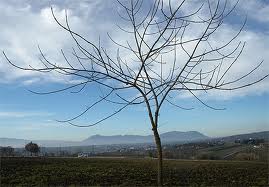A cominciare dai neuroni, le cellule dove avviene lo scambio di informazioni da/verso l'esterno, che hanno le sembianze di un albero: il soma dei neuroni è il tronco, i dentriti sono i rami e l'assone le sue radici.
Il nostro sistema nervoso ha la capacità di adattarsi alle modificazioni dell'ambiente esterno e interno, proprio come gli alberi e i fiori attorno a noi.
Le piante trasportano la linfa, il nostro cervello il liquor, il liquido che trasporta le sostanze e protegge le varie parti del SNC (sistema nervoso centrale).
Il cervelletto, la porzione di cervello deputata al controllo del movimento, è formato al suo interno da una sostanza bianca da cui origina quello che viene chiamato "albero della vita".
Se si osservano le pieghe che formano il cervelletto e lo si sezionasse sagittalmente si vedrebbero come come foglie sospese ai rami di un albero.
Per non parlare delle cellule di Purkinje, vere e proprie piante in miniatura, attorno alle quali viene modulata tutta l'attività del cervelletto e quindi il controllo del movimento dei nostri muscoli.
cellule di Purkinje
E lo sapevate che il nostro corpo può escludere gli stimoli dolorifici a vantaggio di quelli tattili? Seconda la "teoria del cancello" questo avviene perché il cervello preferisce dare importanza allo stimolo che esclude il dolore.
Di fatto quindi, quando stiamo troppo tempo su un pensiero negativo, andiamo contro natura.
Dovremmo prendere esempio dal nostro cervello...
Insomma, che avesse ragione Grace, la dottoressa di Avatar, quando scoprì un legame biochimico tra le radici degli alberi, che li unisce come fossero sinapsi?
Proprio come avviene nel nostro sistema nervoso tra i neuroni (gli alberi) che comunicano tra di loro attraverso le sinapsi (trasmissione dei messaggi chimici ed elettrici).
OUR BRAIN IS LIKE A PLANT
It 'amazing how our nervous system resembles the nature that surrounds us.
Starting from the neurons, the cells where information is exchanged to / from the outside, who have the appearance of a tree: the soma of neurons is the trunk, the dendrites and axon branches are its roots.
Our nervous system has the ability to adapt to changes in the external and internal, just like trees and flowers around us.
Plants carrying the lifeblood, the brain the fluid Liquor that carries substances and protects the various parts of the CNS (central nervous system).
The cerebellum, the portion of the brain that control movement, is formed inside a white substance that give rise to what is called "tree of life."
If you look at the wrinkles that form the cerebellum sagittal section and you would see it as like leaves hanging from the branches of a tree.
Not to mention the Purkinje cells, real miniature plants, around which all activity is modulated by the cerebellum and then control the movement of our muscles.
And did you know that our bodies can be excluded pain stimuli to the benefit of those tactile?
According to the "gate theory" this is because the brain prefers to give importance to the stimulus, which excludes the pain.
In fact, so when we're too much time on a negative thought, we go against nature. We should take example from our brain...
In short, it was right Grace, Dr of Avatar, when she discovered a biochemical link between the tree roots, that unites them as they synapses?
Just as in our nervous system between neurons (the trees) that communicate with each other through synapses (chemical and electrical transmission of messages).




Nessun commento:
Posta un commento